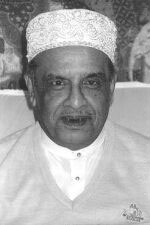
"Religion is matter of experience, an insight into
reality, a direct awareness of the world of values...There is the unknown,
the reserve of truth, which the intellect cannot reach and yet feels to
lie behind.....There is an element of mystery in all religions, an incomprehensible
certainty which is not to be explained by grammar or logic." In the
light of the above statement, the origin of the Radhasoami faith can be
traced in the deep rooted mystic traditions of the country. Established
in 1861, it is essentially an esoteric religion. The edifice of its teachings
rest upon the thought and philosophy of the founder gurus Soamiji Maharaj
and Hazur Maharaj. According to Hazur Maharaj, the second guru, "Radhasoami
faith is not built on the basis of scriptures appertaining to Hindu or
any other religion." Nevertheless it cannot be denied that it inherited
much from the hoary past of Hindu thought and philosophy.
The faith, in fact, came as a bold reaction against prevalent
traditionalism and ritualism of the eighteenth century religion. Its object
was the propagation of a simple religion to assure the spiritual uplift
of the people without any distinction of cast, colour or nationality. Emphasizing
upon the Spirit and the Spiritual life, the Radhasoami faith emerged as
the champion of spiritual awakening in the country that actually preceded
socio-political consciousness. The teachings of the faith are based upon
the inherent call of the spirit, that is, love. The presentation of the
cult of love, with a rational approach to spiritual problems in an age
of science, is a unique achievement of its founders. It can, therefore,
rightly be styled as the first current to revive devotionalism in modern
India.
The Three Paths
Since time immemorial, Moksha (emancipation of
the soul ) has been declared to be the ultimate goal of human life
and for its attainment the sages and seers laid down three paths of karma,gyana
and bhakti. These three ways just conformed to the three aspects
of personality- action, cognition and affection- which are in fact complementary
and supplementary to each other. During the earliest period of Indian history,
karma- marg dominated religion and society. It was principally laid
down in the Vedas, developed and systematized in Brahmanas,
Kalpa-Sutra, Mimamsa and the Bhagwat Puran. When the theory
of metempsychosis and the law of karma came into being, the logical
Hindu mind could not but realize that karma alone could not lead
to salvation. The Upanishads, then, came forth as the first embodiment
of the bold speculations of the recluses and propounded the path of knowledge.
Profound thinking on cosmic origin and human destiny, the nature reality
and its relation to the individual, deliverance of the soul, lead to the
establishment of various schools of thought and philosophy such as Jainism,
Buddhism, Sankhya-yoga and other systems culminating in Vedanta.
The religion based upon the cult of knowledge remained confined to
the intelligentsia or to those who renounced the family and became monks.
It could not satisfy the spiritual thirst of the common people. Their craving
for the higher values resulted in the establishment of the cult of the
Bhakti by such religious leaders as believed that the true path
leading to salvation is neither karma, nor gyana but bhakti
or the true love and devotion for the Lord.
Indigenous Bhakti Traditions
The origin the Bhakti cult is shrouded in mystery. Some
find in it the influence of Islam. Others trace it to Christianity. But
modern research disproves the theory of indebtedness of Indian Bhakti movement
to Christianity and Islam. Bhakti, in fact, can be traced to the
Vedic hymns, the Upanishads, the Sutras and the Bhagwad
Gita. The Vedic hymns to Varuna, Savitr and Usas
are replete with sentiments of piety and devotion. The doctrine of bhakti
or single-minded devotion to God is clearly evident in the later Upanishads.
In the Svetasvatara Upanishad the doctrine Grace is emphasized and
the doctrine of Prapatti or self-surrender is also suggested in
it. The Tattriya Upanishad and Brahadaranyaka Upanishad described
Brahman as the embodiment of bliss and source of all human joys.
Thus the cult of Bhakti is adumbrated in the Vedic hymns
and partly developed in the Upanishads. It blossoms forth in the
epics and later devotional literature; it is not satisfied with the impersonal
Brahman of the Upanishads but converts Him into the personal
God or Isvara as acclaimed by Ramanuja in his theistic Vedanta
or Visistadvaita.
Medieval Bhakti Traditions in Northern India
The medieval Bhakti movement came as a reaction
to Shankaracharya's philosophical theory of Vedanta and Mayavad.
Besides being questioned by scholar - saints on spiritual grounds, the
theory was too philosophical for the common man to comprehend. Hence the
devout Hindus turned to Bhakti. Nevertheless, the impact of Islam
on Indian culture gave a new impetus to the popularity of the Bhakti
cult. The virtual challenge presented by Islam, lead religious men to earnestly
seek the truth of their own faith. Ramanand, fifth in the descend from
Ramanuja, inaugurated in northern India a spirit of synthesis of all that
was true and permanent in our spiritual heritage. He used the popular name
of Rama but he meant by it the perfect God of love and mercy. Not
the unconditioned Brahman of Vedanta but the beloved, the
friend and the Lord of one's heart. When he perceived that God is only
one and humanity is one large family, he started preaching the gospel of
love and devotion. He gave up the use Sanskrit and adopted the language
of the people and freely admitted many a follower of the lower castes to
his fold. Kabir, Raidas, Sena, Dhanna, Pipa, Nabha, Nanak, Dharamdas, Tulsidas,
Surdas and Meera- all followed the path of intense love and devotion.
|
|

